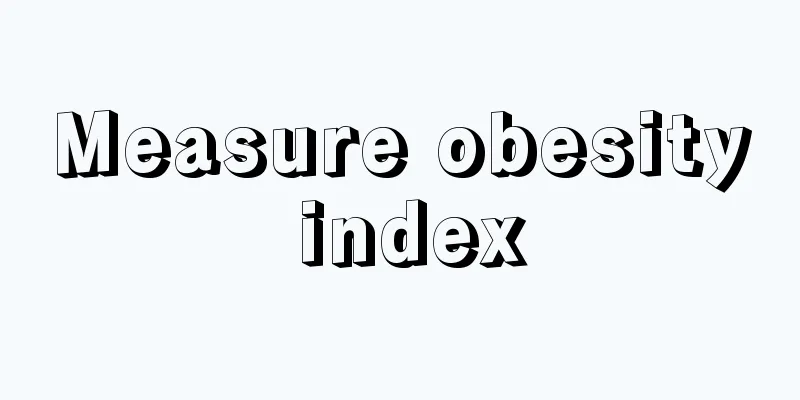Measure obesity index

|
As living standards continue to rise, the number of obese people is also increasing. There are many reasons for obesity, but obesity will not only affect physical health, but also our personal image, especially in this age of appearance and figure. It is very important to have a good figure. There are many types of obesity, and different types of obesity generally require different weight loss methods. What is the obesity index? (1) Weight and standard weight Body weight refers to the total weight of all parts of the human body. Standard weight refers to the standard value of weight for different age groups obtained by conducting large-sample surveys in different countries or regions based on people's age, height and other characteristics. There is currently no unified standard data in our country, and the following method is generally used to calculate standard weight. Calculation method of standard weight for adults: Standard adult weight (kg) = [height (cm) - 100] × 0 9 The standard weight formula commonly used by adults in my country is Broca's modified formula: Adult male: standard weight (kg) = height (cm) - 105 Adult female: standard weight (kg) = height (cm) - 105 - 2 5 In addition, experts from the Academy of Military Medical Sciences of my country have also developed the following standard weight calculation method based on the different characteristics of the northern and southern populations in my country: Standard weight of northerners (kg) = [height (cm) - 150] × 0 6 + 50 (kg) Standard weight of southerners (kg) = [height (cm) - 150] × 0 6 + 48 (kg) The North refers to the provinces north of the Yangtze River, and the South refers to the provinces south of the Yangtze River. Evaluation criteria: The normal range is when the actual body weight is within 10% of the standard body weight; greater than 10% to 20% is overweight; greater than 20% is obesity; less than 10% to 20% is thin; less than 20% is significantly thin. It should be pointed out that the above method has a simple algorithm and is suitable for self-assessment of weight by ordinary people. However, this method is only an estimate and is far less accurate and reliable than methods such as body mass index, waist circumference, and waist-to-hip ratio. (2) Body Mass Index Method The most common and important method for determining standard weight is the body mass index (BMI), which is an equation that determines the degree of body obesity by the ratio of height to weight. The full name of BMI is body mass index. People with a body mass index greater than or equal to 28 are called obese. Body mass index is abbreviated as body mass index, also known as weight index. The calculation formula is weight (kg) divided by height (m) squared. That is: Body mass index = weight (kg) ÷ height (m)2 BMI has been around for many years, but it wasn't until 1998 that the National Institute of Health adopted it as a measurement standard. At present, the BMI index has been increasingly widely used. The Chinese Obesity Expert Group conducted a statistical analysis of 240,000 Chinese adults in 21 provinces, municipalities and autonomous regions across the country for nine months between 2001 and 2002, and concluded that Chinese adults with a body mass index of less than 18.5 are underweight, 18.5 to 23.9 are normal, 24 to 27.98 are overweight, and 28 or more are obese. This standard applies to mainland China and Taiwan. Body mass index is recognized as one of the better measurement indicators for assessing obesity and is widely used in all regions of the world, but it is not suitable for everyone. The following groups are not suitable for this method: ① Infants and children in the growth period; ② People with well-developed muscles or athletes or those doing weight training; ③Pregnant women and the elderly; ④When suffering from diseases such as edema and ascites; ⑤ Those whose height is difficult to measure accurately; ⑥Other individual factors affect weight measurement. (3) Waist measurement Waist circumference (WC) is one of the important criteria for central obesity (abdominal obesity), and there is no recognized and unified data in mainland China. Experts from the China Obesity Task Force believe that the waist circumference of Chinese adult men should be within 85 cm, between 80 and 85 cm is overweight, and 85 cm and above is obese; the waist circumference of adult women should be controlled within 80 cm, between 75 and 80 cm is overweight, and 80 cm and above is obese. People with excessive waist circumference will have a significantly increased risk of cardiovascular and cerebrovascular diseases. Measuring waist circumference should be included in routine physical examinations. In fact, patients can measure this indicator themselves frequently, but they must pay attention to using the correct method. The correct method and operation points for measuring waist circumference: ① Standard tape measure: Use a tape measure without elasticity and with a minimum scale of 1 mm (0.1 cm); ② Fasting: The difference between fasting and full stomach measurements is large. Scientific research shows that fasting measurements should be taken. ③ Bare abdomen: Remove the clothes covering the waist and measure the bare abdomen as much as possible. If this is not possible, try to wear thin clothes; ④ Correct posture: When measuring, stand with your hands hanging naturally, your feet 30 to 40 cm apart, your weight evenly distributed, your abdomen relaxed, and breathe naturally; ⑤ Accurate positioning: Place the tape measure at the midpoint of the line between the upper edge of the hip bone and the lower edge of the twelfth rib on the right mid-axillary line (usually the narrowest part of the waist), and wrap it around the abdomen horizontally, keeping it close but not compressing the skin; ⑥ Accurate reading: Measure the waist length under normal exhalation (breathing out) state, and the reading is accurate to 1 mm. |
<<: How to predict fetal weight
>>: Is it possible to restore pore pits
Recommend
What are the nursing measures for interventional treatment of liver cancer? 8 nursing measures for interventional treatment of liver cancer
Interventional treatment care is mainly performed...
Is bleeding and redness of the nasal lining a nasopharyngeal cancer?
Is bleeding and redness of the nasal lining a sig...
Is liver cancer a digestive tract cancer? Be careful to prevent these 5 common digestive tract cancers
Digestive tract cancer is a disease in which canc...
Can you drink alcohol when you have a cold? It turns out this is the case
Can I drink alcohol when I have a cold? This issu...
What are the typical symptoms of gastric cancer? There are five points
The onset of gastric cancer is accompanied by man...
What should I do if my fingers itch and peel?
With the arrival of spring and summer, many peopl...
What causes black hair on fingers?
The condition of the fingers is very easily affec...
Symptoms of mild degenerative changes in the lumbar spine
There are mild degenerative changes in the lumbar...
Danger! Don't put cooking oil near the stove!
Some housewives who work in the kitchen tend to k...
How much do you know about the early symptoms of tracheitis?
Tracheitis can be acute or chronic, especially ch...
The small intestine reflex area on the sole of the foot hurts
In Traditional Chinese Medicine, it is believed t...
In addition to whitening, what other functions does pearl powder have?
What are the effects of pearl powder? Many people...
How to remove oil stains from clothes
How to remove oil stains on clothes? Nowadays, in...
How to remove ink from clothes
People who often study in class and hold a pen kn...
Hemangioma rupture and bleeding
Vascular disease is one of the most common diseas...









